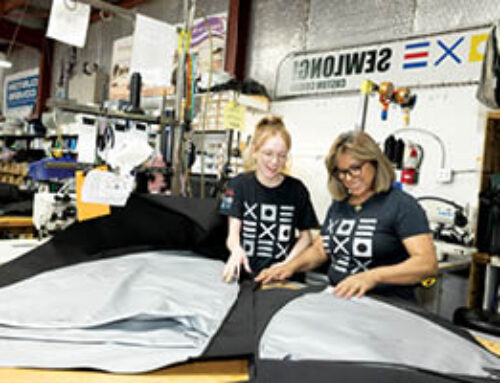Machine head
Faith Roberts’ Banner Canvas is a virtual museum of the history of industrial canvas sewing.
By Jim Tarbox
A first-time visitor to Faith Roberts’ Banner Canvas shop in Ham Lake, Minn. (just north of Minneapolis), might be excused for taking an initial look around and being amazed at the array of equipment and supplies. But as fabricators know, out of such seeming chaos beauty emerges. And Roberts—a certified Master Fabrics Craftsman—has an armful of awards to prove it. She’s also a certified Industrial Fabrics Manager.
Typical of canvas shops everywhere, her space—a 4,000 square-foot pole barn she purchased in 1995, disassembled, moved some 10 miles to its current location, and put it all back together—is filled with the usual collection of seemingly countless rolls of fabric lining the walls and atop and surrounding her gigantic 24- by 8-foot sewing table (which she built); zippers here, bags of grommets there (all within easy reach); a dust-covered stereo cranking out country music; and a hot-pink Snap-on toolbox, one of only two that exist. In the middle of the room is a fishing boat draped in canvas awaiting attention. And assistant Kevin Keiser is busy at one of the table’s built-in machines.
But the highlight of the sprawling room is Roberts’ collection of 20 sewing machines, some dating to the early 1900s. They all work, and she uses them all. And not just for marine fabrication: Roberts has been invited to bid on work for the National Football League’s Super Bowl, she has accepted assignments from defense contractor Lockheed Martin for air diverters on Tomahawk and Cruise missiles, and she recently created some “vehicle covers” for the Minneapolis Police Department’s K-9 unit.
As is the case with many fabricators, Roberts came to the industry indirectly. After receiving a degree in apparel design and working for Munsingwear in the Twin Cities—she also spent five years making bridal gowns—she returned to the Twin Cities and got a temporary job with a family of Russian immigrants who started their business in 1912; they bought old rags and made bags. (Situated near the north end of the Mississippi, Minneapolis’ history is built on the milling business.) The temp work turned into steadier contract work, and when the third generation of the family turned to practicing law a year later, she bought the business and its assets, including the machines.
Though she wasn’t much into boats early in her career as a fabricator—Roberts initially concentrated on flags and banners; a supplier pointed her to IFAI, with which she was the first woman to chair what was then the banners, flags and graphics division—she gradually picked up more and more marine work. She worked with a consultant to learn about marine fabrication, and it is now her major focus. She does own a 22-foot Crestliner, but gets to use it only sporadically. She also tried her hand at developing a series of instructional videos, she said, but that effort “petered out.”
In addition to the machines she “inherited” when she bought the business, Roberts has obtained other machines she needs from shops going out of business and auctions.
Among her oldest machines is a Samson 38200 Union Special, built at the turn of 20th century. It’s a 200-plus-pound triple-needle behemoth that features a 30-inch arm and puller. She referred to it as an example of a “black head” machine, which generally describes machines built from the 1900s to the 1930s. “Gray heads” are machines built in the ’30s to ’50s, and newer machines are “white heads.”
While some of her machines serve only a single purpose—a Singer 107-V1 is used to sew edging on scalloped leather for awnings and boat-lift covers—others, even at 50 years of age, are pressed into service nearly every day. Roberts calls her Consew 226 with a reverse walking foot a “work horse.” And an open-arm Mitsubishi CU-865 from the early 1990s, with which she makes inflatable work baffles, paid for itself in six months.
Among other machines she’s proud to show off, Roberts takes particular pride in a humongous No. 3 Eyelet machine with tooling for No. 2 Plain Washer grommets that has been moved twice. She’s had to have welding repairs, and she does have a back-up that she bought at an auction. Then there’s the Brother LT2-B838 double-needle lock-stitch 3/8-inch gauge machine, an Adler 272 twin-needle lock-stitch 7/8-gauge used to hold down Velcro and webbing, and a Sundia EA4-975M used for edging so the fabric doesn’t unravel (it’s a machine used primarily on apparel).
Then there’s the Singer 144W-305 walking-foot lock-stitch big-bobbin unit that she used to stitch the binding on a marketing booklet she created for the Converse athletic-shoe company, a job she got through her contacts with the Minnesota Timberwolves professional basketball team, and a Singer 300-W205 chain stitch 1/2-inch-gauge with puller and double needle used to stitch feed bags.
Aside from those projects for Cruise and Tomahawk missiles, perhaps the most intriguing job Roberts has taken on was building portable cow barns and making veal-calf “cow pillows” for cattle ranchers. Minneapolis might like to refer to itself as the “Little Apple,” but it’s still a long way from the bright lights of New York City.
Jim Tarbox is editor of Marine Fabricator.
 TEXTILES.ORG
TEXTILES.ORG 






